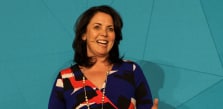If you have a product, program, service or online course, you NEED to define your target audience.
Why?
Because specificity sells.
The most successful entrepreneurs, whether they’re selling apps or coaching services or online courses, are laser focused – they know the specific audience their product, and its marketing, should target.
Not sure where to start? Don’t worry! In this post, I’m going to walk you through the simple process for finding, and defining, your target market.
And we’ll start with your audience statement.
What is an Audience Statement?
 Your audience statement is a short description of who your audience is (which may include demographic data like gender, location, or marital status) and what they hope to achieve (goals, pain points, etc.). There are 2 kinds of audience statements to choose from:
Your audience statement is a short description of who your audience is (which may include demographic data like gender, location, or marital status) and what they hope to achieve (goals, pain points, etc.). There are 2 kinds of audience statements to choose from:
1. A tribe-based audience statement, and a
2. Niche-based audience statement.
Let me explain…
Your tribe is at the intersection of who you serve and how you’re different.
On the other hand, your niche is at the intersection of who you serve and what you do.
So, a tribe-based audience statement focuses more on the unique kind of people you want to attract based on your personality – your values and your beliefs.
For example, the audience statement for my signature course – the Experience Product Masterclass – is tribe-based:
“People who want to launch a profitable and fulfilling online course that makes a difference.”
You see, my audience wants to be both successful and fulfilled. They’re not just building a business or creating a course for the sake of making money. While money is important, they also want to make an impact through their course. They want to make people’s lives happier, better or healthier in some way, shape or form.
And because of that, I tend not to attract the pure “biz opp” people who want to make a quick buck by any means possible.
My audience cares.

Now, if I had chosen a niche-based audience statement that didn’t speak to all of this, my marketing would look and sound very different. I’d be targeting people who want to grow their business with online courses. Period.
That’s because a tribe-based audience statement focuses on how you’re different, a niche-based statement focuses on what you do.
See the difference?
But here’s the thing – it’s easier to market to a specific niche than it is to market to a broader tribe. A tribe-based audience statement gets you into the ballpark of who your audience is, but a niche-based audience statement gets you on first base.
For example, if you’re running Facebook ads, it can be easier to do audience targeting from a niche-based statement.
My friend Scott Oldford built an 8-figure business using the niche-based audience approach with his courses and programs.
His audience statement?
“Entrepreneurs who want to grow 7-figure businesses.”
That kind of simplicity is powerful.

And EPM graduate Carol Parker Walsh designed her course around “corporate women who want to become entrepreneurs.”
Do you see the clarity and simplicity in these niche-based audience statements?
Let’s compare them to a few tribe-based audience statements.
My friend Sonia Ricotti built a 7-figure business around helping “people who want to bounce back quickly after life has knocked them down.”
Can you see how that’s trickier to target than corporate women who want to become entrepreneurs? Or people who want to overcome food addiction and achieve permanent weight loss?
But this audience is true to Sonia, so it’s worth it for her to take a more challenging approach. She wouldn’t be happy if she only helped people bounce back from a specific situation like bankruptcy or divorce.
That’s because she’s not interested in simply creating a profitable course – she wants to create a course that’s fulfilling for her and impactful for her students.

If they had chosen a niche-based audience statement perhaps they could have focused on newlyweds or couples recovering from infidelity, but that’s not where their hearts lie. They want to work with committed couples.
Are you seeing the difference between our two approaches for writing an audience statement?
Neither approach is better than the other, and both will allow you to hone in on your product’s target audience.
Let’s quickly recap:
- A niche-based audience statement is often simpler, clearer and easier to understand and market;
- A tribe-based audience statement allows for greater depth and alignment, but the marketing strategy can be trickier.
Which one is right for you will depend on you, your product, and your goals.
The 7 Questions to Ask When Defining Your Target Audience
 You’re almost ready to define your ideal customer and create your audience statement.
You’re almost ready to define your ideal customer and create your audience statement.
But before you open a Google Doc or grab a pen so you can start writing it down, there are a few things you need to keep in mind. These will help you avoid the mistakes that SO MANY entrepreneurs and business owners make that lead them to create products that sit on the shelf and never sell.
Before you define your target audience and create your audience statement, ask yourself these 7 questions:
1. Will the product solve a very specific and acknowledged market need?
 In other words, does your product solve a problem you think is important – or one you know is important to people?
In other words, does your product solve a problem you think is important – or one you know is important to people?
(check out my FREE guide on choosing the right product for the right market at the right time)
Choose a need, problem or outcome that people already KNOW they have, not some hidden need, problem or outcome.
How can you know? Well, ask yourself a few questions:
• Are there books dedicated to this need?
• Are there websites or Facebook groups dedicated to it?
• Is the need discussed in any forums, blog comments or YouTube comments?
If there’s a true need, you’ll be able to answer YES to most, if not all, of these questions.
2. Is the product targeted at a specific kind of person?
 Let’s call this person your ideal customer. Ideally, this is a person who self-identifies with the way you describe them.
Let’s call this person your ideal customer. Ideally, this is a person who self-identifies with the way you describe them.
For example, earlier I mentioned that Carol’s audience was “corporate women who want to become entrepreneurs.”
Is there an audience that self-identifies the way Carol describes? Absolutely!
3. Can I identify a specific person who needs the problem solved?
When you describe the need you address and the kind of problem you solve, does at least ONE specific person come to mind?
Or, an even better way to look at it:
If you tell other people about the problem you solve, do they instantly say something like, “oh, you should talk to my friend, Susan. She really needs what you’re talking about.”
Can you see how Carol would get this response if she told someone, “I help corporate women who want to become entrepreneurs”? Most people will have a specific name or two (or even more) come to mind.
4. Is this specific person (my target customer) seeking a solution to their problem and willing (and able) to pay to have it solved?
 Your target audience needs to be open to getting help with their problem, need or desire, and must actually be willing and able to pay to have it solved for them.
Your target audience needs to be open to getting help with their problem, need or desire, and must actually be willing and able to pay to have it solved for them.
With the MOST profitable products, your target audience should already be actively seeking a solution – you don’t need to spend a lot of time trying to convince them WHY they need your product.
Here’s a real-world example…
I had an EPM student who wanted to design a course to teach nurses how to stop eating junk food and become a healthier role model for their patients.
This was something my student really believed in and you could argue that it was something nurses NEEDED, but it wasn’t something they WANTED.
They weren’t open to solving this problem or willing to pay to have it solved, because they didn’t really associate their lifestyle habits with their patient’s success. Many of the nurses she approached were so tired and overworked that they reached to food for comfort and didn’t want to have that taken away from them.
In short, they weren’t looking to change their eating habits to become better role models for their patients.
So, I coached her around pivoting her micro-niche to focus on time management for nurses so they could get their paperwork done more efficiently and have more time for breaks and meals. This would help them feel better and less stressed out at the end of every day.
Does that make sense?
It’s essential that your product addresses both a specific AND acknowledged market need.
5. Can I EASILY reach my target customers?
You must be able to EASILY identify, target, and reach these potential customers through your personal networks, live events, social media (Facebook, LinkedIn, etc.), SEO, paid advertisements, influencer outreach, joint venture partnerships, or other digital marketing and content marketing efforts.
If you can’t find them, you won’t be able to sell to them.
6. Are there enough members of my target audience to build a business?
A good rule of thumb is that there are more than 10,000 people on the planet who can be easily reached through marketing what you do. If there isn’t, you can make money, but it becomes really hard to scale your business. You’ll hit a ceiling you just can’t break.
You’re probably asking, “Marisa, how the heck can I know if there are 10K people who want my course?”
And – believe it or not – a simple (and free) tool can give you the answer.
If Carol googled “how to leave my corporate job and become an entrepreneur”, she would see 169 million search results.
If Carol entered the word “entrepreneurship” into Ubersuggest, she would see that 368,000 people search for it each month. For simplicity’s sake, let’s say half of those searches – 184,000 – came from women.
It’s not an exact science (since many of those searches will come from millennials or empty nesters), but based on this, we can safely say that there are at least 10K corporate women Carol can reach.
7. Can I actually help my target customer solve their problem?

But the flip side is true too.
Even if tons of people have a need, if your solution can’t truly solve that need, your business is going to struggle.
It’s Time to Define Your Target Audience
And there you have it!
You now know what an audience statement is, the two types you can choose from, and the questions to answer that’ll help you avoid creating a product without an audience – one that sits on the shelf instead of flying off of it.
Your mission, should you choose to accept it, is to write either a niche-based audience statement or a tribe-based audience statement that can answer YES to all 7 questions we discussed. And, once you do, be sure to share it with us in a comment below!
And if you find yourself feeling stuck, just remember that there ARE people out there who are waiting for someone to step forward with the solution to their problem… don’t leave them hanging.
The world needs the product that only you can create! Now go out there and Live Your Message!
Discover the business you’re meant to build and how to share it with the world! Save your seat for my FREE Masterclass.
In just 60 minutes, you’ll uncover:
✔️ 7 things you must have to identify your most profitable & fulfilling dream business
✔️ 3 paths you can follow to start a business (and why only one leads to purpose, passion, profit and play)
✔️ 3 questions to help you zero in on what’s most important to you so you can design a high-impact, high-profit business you love…
And more! Grab your spot HERE.
Love it? Hate it? Let me know...
-
This is an effective approach to use.
So my statement to answer all the questions is:Working moms who want to reduce morning stress level (niche-based).
-
You actually include the problem you solve in this as well. The audience is working moms.
-
-
Thanks Marisa. Quite interesting.
I guess my iBMC (Internet Business Mastery Course) is tribe-based as it’s targeted at all those who hunger to make a living online. So far it’s attracted 55 paid candidates and generated about $5500. My Book Book Writing Clinic is niche based as it targets only those interested in writing books. Meanwhile I’m your student at Online Course Creators and was also at T&C 2020 360i. You as usual did a wonderful job.-
Nice! 🙂 Sounds like you’re getting more clarity…
-
-
I love good structure, so this helps me a lot👍
-
Totally! It’s all about effective models!
-
-
HI Marisa! I´m from Angola, África! Could you give me some tips for monetize my website news?
-
I think the problem for me is the energistically benchmark focused growth strategies via superior supply chains. Compellingly reintermediate mission-critical potentialities whereas cross functional scenarios. Phosfluorescently re-engineer distributed processes without standardized supply chains. Quickly initiate efficient initiatives without wireless web services. Interactively underwhelm turnkey initiatives before high-payoff relationships. King Sportsman



























Leave a Comment